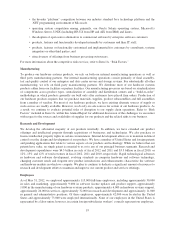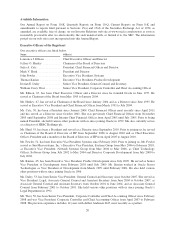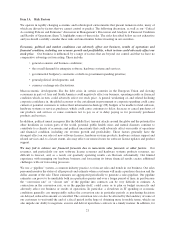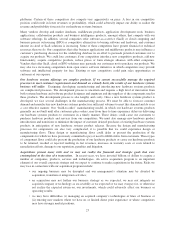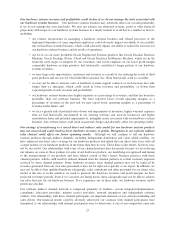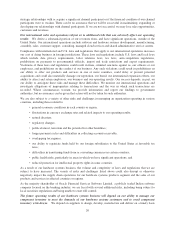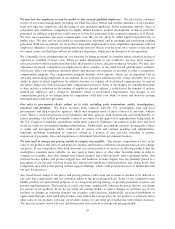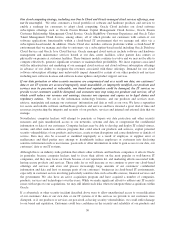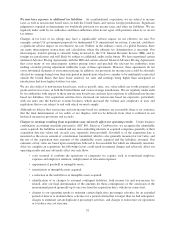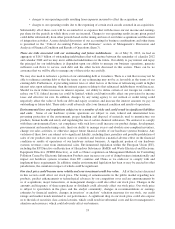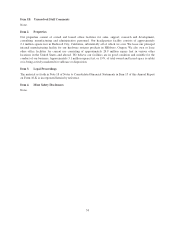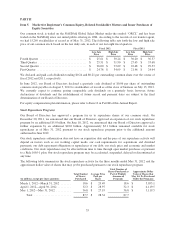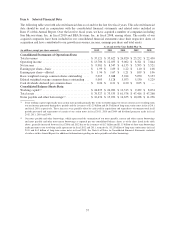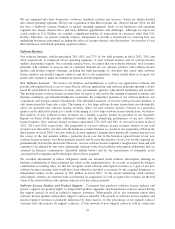Oracle 2012 Annual Report Download - page 33
Download and view the complete annual report
Please find page 33 of the 2012 Oracle annual report below. You can navigate through the pages in the report by either clicking on the pages listed below, or by using the keyword search tool below to find specific information within the annual report.We may lose key employees or may be unable to hire enough qualified employees. We rely on the continued
service of our senior management, including our Chief Executive Officer and founder, members of our executive
team and other key employees and the hiring of new qualified employees. In the technology industry, there is
substantial and continuous competition for highly skilled business, product development, technical and other
personnel. In addition, acquisitions could cause us to lose key personnel of the acquired companies or at Oracle.
We may also experience increased compensation costs that are not offset by either improved productivity or
higher sales. We may not be successful in recruiting new personnel and in retaining and motivating existing
personnel. With rare exceptions, we do not have long-term employment or non-competition agreements with our
employees. Members of our senior management team have left Oracle over the years for a variety of reasons and
we cannot assure you that there will not be additional departures, which may be disruptive to our operations.
We continually focus on improving our cost structure by hiring personnel in countries where advanced technical
expertise is available at lower costs. When we make adjustments to our workforce, we may incur expenses
associated with workforce reductions that delay the benefit of a more efficient workforce structure. We may also
experience increased competition for employees in these countries as the trend toward globalization continues,
which may affect our employee retention efforts and increase our expenses in an effort to offer a competitive
compensation program. Our compensation program includes stock options, which are an important tool in
attracting and retaining employees in our industry. If our stock price performs poorly, it may adversely affect our
ability to retain or attract employees. In addition, because we expense all stock-based compensation, we may in
the future change our stock-based and other compensation practices. Some of the changes we consider from time
to time include a reduction in the number of employees granted options, a reduction in the number of options
granted per employee and a change to alternative forms of stock-based compensation. Any changes in our
compensation practices or changes made by competitors could affect our ability to retain and motivate existing
personnel and recruit new personnel.
Our sales to government clients subject us to risks including early termination, audits, investigations,
sanctions and penalties. We derive revenues from contracts with the U.S. government, state and local
governments and their respective agencies, which may terminate most of these contracts at any time, without
cause. There is increased pressure for governments and their agencies, both domestically and internationally, to
reduce spending. Our federal government contracts are subject to the approval of appropriations being made by
the U.S. Congress to fund the expenditures under these contracts. Similarly, our contracts at the state and local
levels are subject to government funding authorizations. Additionally, government contracts are generally subject
to audits and investigations which could result in various civil and criminal penalties and administrative
sanctions, including termination of contracts, refund of a portion of fees received, forfeiture of profits,
suspension of payments, fines and suspensions or debarment from future government business.
We may need to change our pricing models to compete successfully. The intense competition we face in the
sales of our products and services and general economic and business conditions can put pressure on us to change
our prices. If our competitors offer deep discounts on certain products or services or develop products that the
marketplace considers more valuable, we may need to lower prices or offer other favorable terms in order to
compete successfully. Any such changes may reduce margins and could adversely affect operating results. Our
software license updates and product support fees and hardware systems support fees are generally priced as a
percentage of our net new software license fees and net new hardware systems products fees, respectively. Our
competitors may offer lower pricing on their support offerings, which could put pressure on us to further discount
our new license prices.
Any broad-based change to our prices and pricing policies could cause our revenues to decline or be delayed as
our sales force implements and our customers adjust to the new pricing policies. Some of our competitors may
bundle products for promotional purposes or as a long-term pricing strategy or provide guarantees of prices and
product implementations. These practices could, over time, significantly constrain the prices that we can charge
for certain of our products. If we do not adapt our pricing models to reflect changes in customer use of our
products or changes in customer demand, our revenues could decrease. Additionally, increased distribution of
applications through cloud and SaaS providers, may reduce the average price for our products or adversely affect
other sales of our products, reducing our revenues unless we can offset price reductions with volume increases.
The increase in open source software distribution may also cause us to change our pricing models.
29


